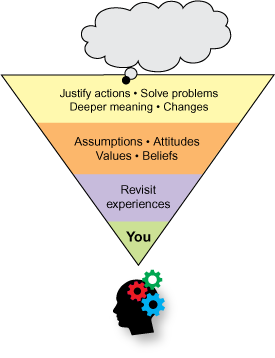2 What is reflective thinking?
‘Reflective thinking’ may appear an abstract concept – how can it be explained? To help understand the broader concept, a simple way in which reflective thinking can be defined is: consciously thinking about and analysing:
- what you are currently doing
- what you have previously done
- what you have experienced
- what and how you have learned.
At its core, ‘reflective thinking’ is the notion of awareness of one’s own knowledge, assumptions and past experiences. Your past learning and experience provide the context for your thoughts, and are therefore unique to you, but reflective thinking is a dynamic process that continues to develop and evolve as you learn and respond to new experiences, situations, events or information. In practical terms, this is the process where you interpret and evaluate your experiences, check that they make ‘sense’ to you, create meaning, justify actions and solve problems, and it helps with your future planning (see Figure 1).
Dewey’s (1903, p. 9) notion of ‘how we think’ as being an ‘active, persistent and careful consideration of a belief or supposed form of knowledge in the light of the grounds which support it and the further conclusions to which it tends’ provides the foundation for understanding reflective thinking and reflective practice.
Box 1 ‘Reflective’ and ‘critical’ thinking: a note concerning use of terms
You may find that the terms ‘reflective thinking’ and ‘critical thinking’ are sometimes used interchangeably in the literature. As forms of reflective enquiry, ‘reflective thinking’ and ‘critical thinking’ are certainly closely linked. They are active, structured, and systematic processes that denote levels of thinking beyond other activities that you might engage with day to day. We explore reflective thinking in this session, and will discuss critical thinking and critical analysis separately in Sessions 3 and 4.
Reflective thinking explores different reasons for, considers the potential implications of, and is influenced by an individual’s attitudes or practices. It is a process that allows you to make meaning of an experience, involves analytic and critiquing elements, and can be articulated through spoken, written or other forms of expression. ‘Analysis’ in this context is the process of breaking a complex topic into smaller parts to gain a better understanding of it, and ‘critiquing’ involves a questioning approach to knowledge, checking assumptions. An individual who engages in reflective thinking will question their own assumptions and understanding, and think about issues from a variety of perspectives. This type of ‘higher-order’ thinking can be developed through practice, but it involves understanding, internalising and applying some key concepts to evaluate your own learning.
‘Reflective practice’ is widely considered to be important for professional development and vocational learning. It is a process where the ‘reflective practitioner’ stops to think about their practice, consciously analyses their decision-making, draws on theory and evidence, and relates this to what they do in practice. The term derives from the works of Dewey and Schön. Dewey (1910) said that reflective practice ‘enables us to direct our actions with foresight … it enables us to know what we are about when we act’. Schön (1983) expanded this to include two aspects: reflection-in-action and reflection-on-action.
- Reflection-in-action refers to the quick thinking and reactions that occur as you are engaged in an activity. Your reflection-in-action allows you to observe a situation, consider why it is happening, and respond by doing it differently.
- Reflection-on-action is what occurs when you consider the activity again. You may think more deeply about the reasons, what caused the situation, what options were open to you, why you chose one option and not another. Your responses will depend on your existing level of knowledge and experience, your understanding of theories and your values.

